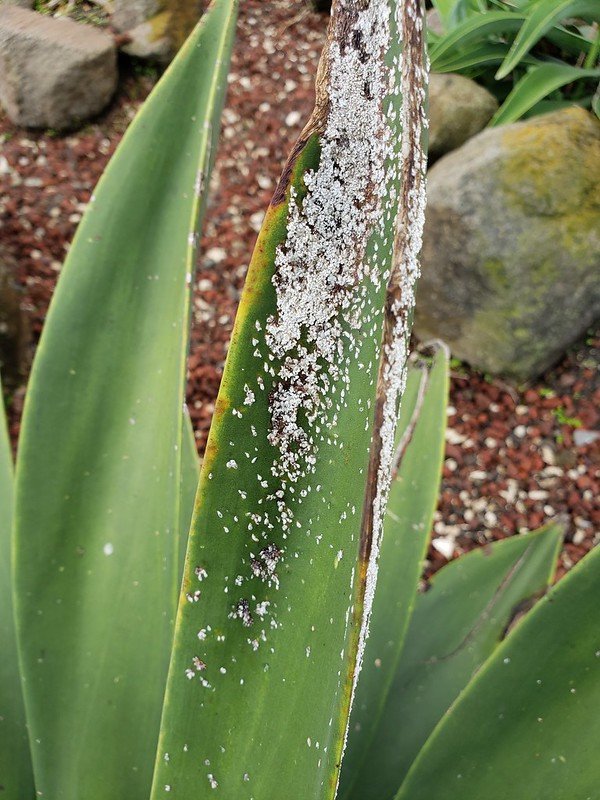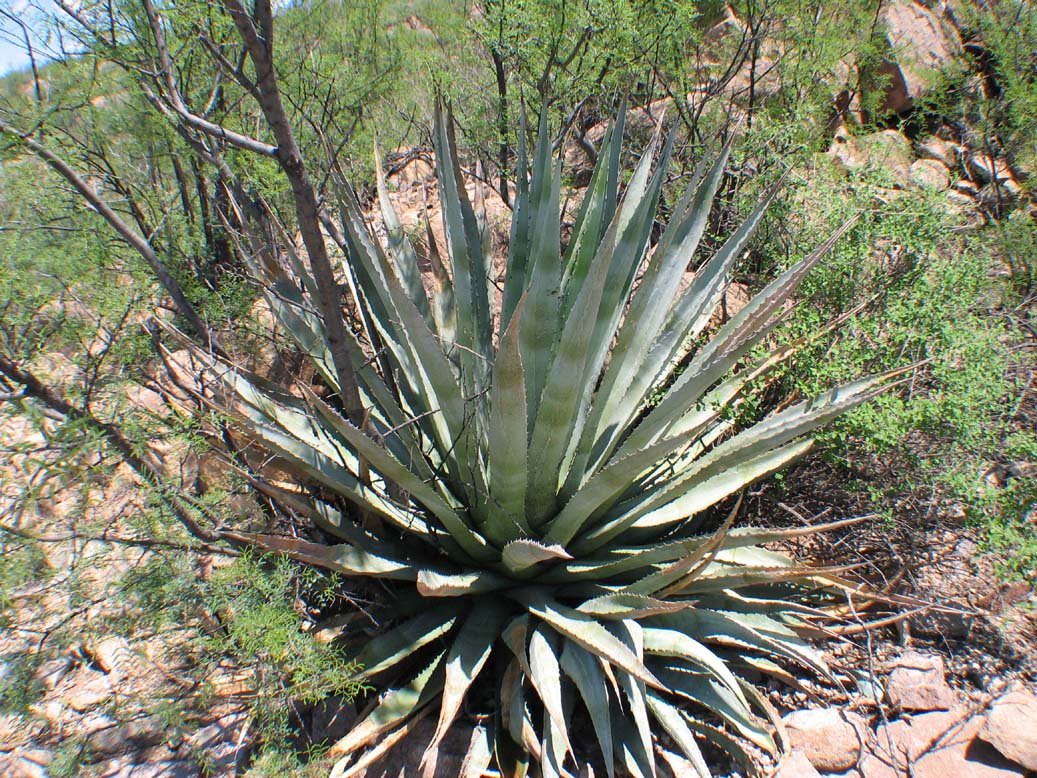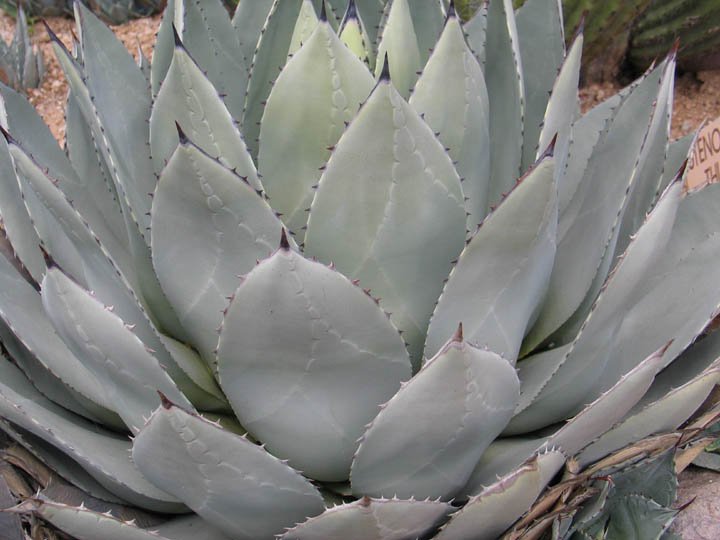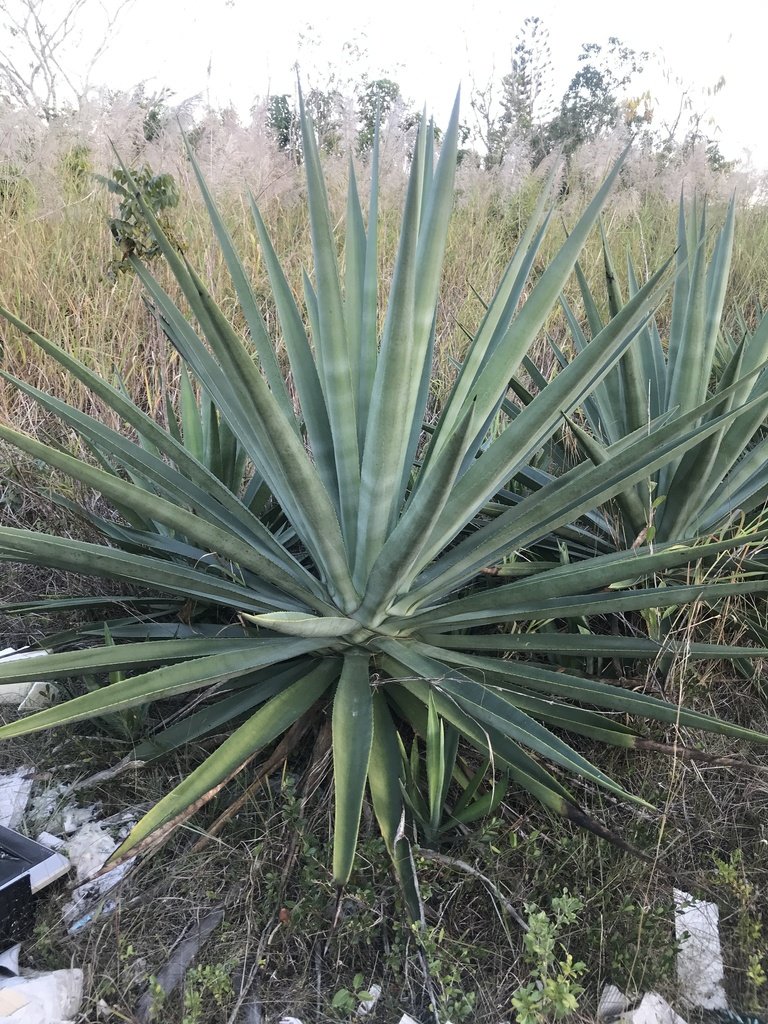The Extraordinary Century Plant
Agave species
Family: Asparagaceae
Agaves are some of the most extraordinary plants in the world. They are monocots, which include lilies, grasses, bamboo, bromeliads, banana plants, gingers, etc. Agaves are succulent plants that usually grow in rosettes. Some rosettes sucker with “pups” others only form a singular rosette.
Agaves can be very small, like Agave x pumila which only grows about 2-4” tall and wide, or enormous with leaves that are 14’ long like Agave atrovirens which, at the end of its life, will put up a bloom stalk that can approach 50’ tall! The foliage color varies from greens, to blues, to silvery grays, and some even develop reddish or purplish coloring on the foliage. And of course there are always mutations that become collectible selections—variegation, crests, monstrose plants, etc.
Photo of Agave parryi var. huachucensis by Doug Felt, iNaturalist
Pulque Agave (Agave atrovirens) is the biggest agave in the world. The leaves can be almost 15' long, and the bloom can reach about 50' tall. Photo by Luis Alberto, iNaturalist
This agave (Agave x pumila) is thought to be a hybrid, and is of unknown origin. Plants grown in the ground have grown bigger, but plants in pots only grow 2-4" tall and wide. Photo by Ezequiel Coelho, iNaturalist.
The smallest *actual* species of agave is the Santa Cruz Agave (Agave parviflora) which generally gets about 6" tall and wide and is native to Arizona in the United States and Sonora in Mexico. Photo by jorgeortizv, iNaturalist
The genus name, Agave, come from the Ancient Greek agauê meaning "illustrious, noble" having to do with very tall flower spikes found on its many species. Agaves are all considered monocarpic—which means that they only flower once, at the end of their lives, and put all their energy into reproduction—flowering and producing seed. Some species also produce bullbills— small, bulb-like structures that grow into small clones of themselves. The bloom will come out of the center of the rosette, and usually rise pretty far above the plant. This bloom, especially when it first emerges from the center of the rosette, looks like a giant asparagus, and helps one understand how this plant can be in the same plant family as asparagus.
Technically, calling all agaves monocarpic isn’t exactly true. And it all depends on what you consider the individual: most Agave species produce “pups” or clones of themselves. But looking at how the plant is connected, and how the plant as a whole shifts resources from one part to another, those “clones” aren’t really clones but part of the whole plant—they become clones when they are separated from the group and dependent on their own roots. When most agaves bloom, the individual rosette slowly declines, and dies, but the “pups” carry on, often still connected to each other. Of course, Agave species are solitary, and indeed are finished after they’ve completed their reproduction cycle.
People often get sad when their agaves bloom. But really, it is something to be celebrated, and admired. What the agave does during that time is remarkable and beautiful. The flowers occur on what is often an enormous stalk—even the small species put our tall stalks, when comparing that stalk to the plant. Those flower stalks have come to rely on interesting groups of pollinators, like bats. And the bats, over time, have shaped their behavior to be at certain places when these agaves bloom. When agaves bloom, so much happens—its not just the primary pollinator of the species that make this interesting, but the host of insects that scurry to use this resource of incredibly rich nectar.
Agaves have been incredibly important to human beings as well. Agaves spend their life growing, and storing starches within their tissues within each rosette. When it comes time to bloom, those starches convert to an incredible amount of sugars and other resources, all purposed toward the production of flowers and then seed—reproduction is always an expensive endeavor for an organism, requiring lots of resources. Agaves do it all at once. The result is a huge resource of sugars and starches that we repurpose for our own needs—either as a food (pit baked agave), as sugars (agave syrup), and fermented and distilled spirits (pulque, mescal). The fibers of agave are also very important to human beings and have been made into everything from rope to clothing. Even the old blooming stalks have been important as building material.
Photo of purse made with sisal fiber (fiber from Agave sisalana) by Achim Raschka, Wikipedia
Agaves should not be treated all the same. Though most species are definitely succulent, low water-using plants, they don’t all need full sun or even want it. Pay attention to the individual needs of each species, and try to give them conditions similar to those they evolved in.
Most agaves probably appreciate afternoon shade in the low desert (especially these days) and many thrive in shady, filtered sun conditions. Many agaves struggle in our urban landscapes with concrete and landscape gravel causing more than just full sun conditions (reflective heat). And remember that the most common biome agaves are found in are oak forests, not low elevation deserts. This means having some shade once in a while, and soil with some organic material, is beneficial to them.
When in the ground, most agave species appreciate a good watering a few times a month in summer—winter watering isn’t too necessary unless there has been no rain. Plants in containers will need water more often—1-2 times a week in summer, once a month or so in winter.
The real variable horticultural element for agaves is cold hardiness. Some agaves can take a surprising amount of cold. Agave havardiana and A. neomexicana can take temperatures as low as -20°. Many other agaves are very frost tender and should be in a greenhouse in our region.
Agave Pests
Agaves, like all plants, have relationships with other organisms that sometimes inconvenience the human being who is mostly interested in their own purpose for the plant. Below are some of those organisms with some notes. We don’t recommend fighting these organisms too much. Many of them are not really preventable. The effects of the chemicals used to try to control such organisms are incredibly harmful to the other organisms in our ecology. The more we an accept that we share our environment with other organisms and that often what we don’t want to happen may result, the more we can develop living landscapes rather than toxic ones.
The agave snout weevil (Scyphophorus acupunctatus) uses agaves to host their larvae. Being a weevil, it has a protruding snout and chewing mouthparts. The adult female enters the base of the plant to lay eggs in the spring. These eggs hatch into larvae (grubs) that feed on the succulent core of the plant. The weevil’s damage is significant, but the weevil opens the plant to decay microbes which enter the plant causing it to die and collapse from the base upward. The larvae have chewing mouthparts and develop in the dying plant. In our region, seem to be most attracted to non-native agaves like A. americana. They also tend to prefer plants that are somewhat stressed out (like the common underwatered plants found in urban areas). Often, many pups of the agave will survive and continue on after the main agave rosette has "melted and died".
The agave plant leaf bug (Agaveocoris barberi) can cause lots of white or yellow dots from feeding on the leaves of agaves. They usually don't kill a healthy plant but they can make it look less attractive. Its noteworthy that most wild agaves have lots of these feeding blotches, and that the perfect-looking agave that people, especially plant collectors, try to maintain is rare in the wild. Plants that are over-shaded can be more susceptible to these insects than others.

There is a problematic mite that makes agaves look really bad--Oziella is a group of Eriophyoid mites that includes agave mites, which are also known as grease mites. These microscopic mites are tiny and wormlike, with four small legs around their head. Adult agave mites are translucent and pale whitish in color. If you see excessive scabbing accompanied with what looks like greasiness around the scabbing, this is the mite. There isn't much you can do about these if they hit your agaves. Most agave people will just tell you to dispose of the plant.

Coccid scale insects are tiny and have a flattened, plate-like cover that's less than 1/8 inch in diameter. When several scale insects are on a plant, it can look like the plant has reptile-like scales. They are pretty rare but if they appear it is usually because the plant is in too much shade and/or drought stressed. Photo by Scot Nelson, Flickr
Agaves, like cacti, are not always easy to identify. The genus displays incredible diversity. There are many species that look very, very similar and are hard to tell apart. Yet, there are species that have individuals that look very different yet are the same species. This genus confuses even the experts at times. Agaves and close relatives have long presented significant taxonomic difficulty. These difficulties could be due to the relatively young evolutionary age of the group (major diversification events of the group most likely occurred 8–10 million years ago), ease of hybridization between species (and even genera), incomplete lineage sorting, and long generation times. Within a species, morphological variations can be considerable, especially in cultivation; a number of named species may actually just be variants of original wild-type species that horticulturalists bred to appear unique in cultivation. Add in the enthusiasm behind the plants with their experts and enabled novices, and you have a recipe for lots of uncertainty.
That’s ok, you don’t have to lose your mind over it all. A real scientist is ok with not exactly understanding what they are looking at. Sit with the uncertainty and keep observing the plants. You also don’t need to known exactly what species every plant is to appreciate its existence and participation in ecology. And its OK to say, “I’m not totally sure” even if you are a botanist or experienced horticulturist. For many of us, this is part of the allure of these plants.
Species Profiles

American Century Plant (Agave americana)

Green Glow Agave (Agave attenuata x ocahui)

Mezcal Ceniza (Agave colorata)

Mexcalmetl (Agave horrida)

Chahuiqui (Agave multifilifera)

Sharkskin Agave (Agave nickelsiae x scabra)

Ocahui (Agave ocahui)

Palmer's Agave (Agave palmeri)

Agave parryi (and its variants)

Sisal Agave (Agave sisalana)











